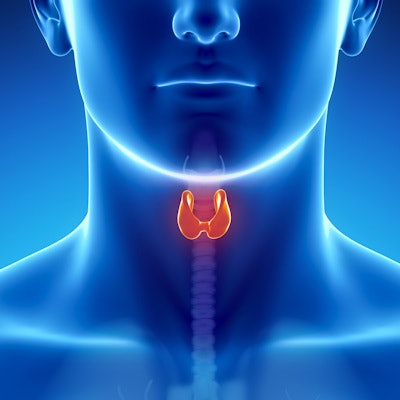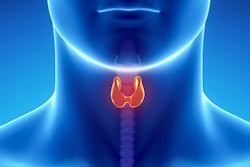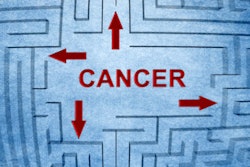
Two studies from the U.S. and South Korea are raising questions about the role of ultrasound screening and thyroid cancer incidence. Researchers specifically address the issue of overdiagnosis in studies published in the December 24/31 issue of the Journal of the American Medical Association.
Researchers from both countries documented periods of sharply rising incidence of thyroid cancer that followed the implementation of ultrasound-based screening programs. Rising incidence then prompted scrutiny of screening, which was then followed by a decline in incidence (JAMA, December 24/31, 2019, Vol. 322:24, pp. 2440-2443).
"Although a true decline in the occurrence of thyroid cancer is a possible explanation for these changing trends, less intensive workup of thyroid nodules is more likely," wrote the U.S. authors, led by Ann Powers, from the Icahn School of Medicine at Mount Sinai in New York City.
The U.S. study found that the incidence of thyroid cancer tripled from 1974 to 2013, increasing from 4.5 cases per 100,000 people in 1974 to 14.4 cases per 100,000 in 2013. While the gain was attributed primarily to better detection of small subclinical thyroid cancers, Powers and colleagues did not dismiss the possibility of a "concurrent increase in the true incidence of disease."
They cited previous studies in which autopsy results from an estimated 4% to 11% of people with no evidence of thyroid disease uncovered "clinically occult thyroid cancers, suggesting that increasing healthcare utilization and imaging technologies have led to the detection of increasing numbers of cancers, without a change in the actual occurrence of thyroid cancer."
The rate of increase in thyroid cancer cases did slow significantly from 2009 (13.8 per 100,000) to 2014 (14.7 per 100,000) (p < 0.001), but it then declined by 2.4% from 2014 to 2016.
Powers and colleagues suggested that the changes over the last 10 years came "during a time of evolving understanding of overdiagnosis and the indolent nature of many small thyroid cancers, reflected in changing clinical practice guidelines, including recommendations against screening for thyroid cancer by the U.S. Preventive Services Task Force in 2017."
On the other side of the world, South Korean researchers, led by Dr. Song Vogue Ahn, PhD, from Ewha Womans University in Seoul, laid the blame for rising thyroid cancer incidence on the launch of a national cancer screening program in 1999 in which ultrasonography was used to detect thyroid cancer. As a result, the incidence rate for the disease rose from 7.2 per 100,000 in 1999 to 68.7 per 100,000 in 2011, with most of those patients treated surgically through thyroidectomies.
Given the meteoric 12-year rise, the country became concerned about overdiagnosis and discouraged ultrasound screening in 2014. This change of heart coincided with lower incidence of thyroid cancer and fewer thyroidectomies, Ahn and colleagues discovered. For example, they calculated a rate of 70.1 thyroidectomies per 100,000 in 2012, compared with 23.6 thyroidectomies per 100,000 population in 2016.
Therefore, the researchers concluded that the initial increase in thyroid cancer cases in the last decade "might be linked to the initiation of a national cancer screening program [in 1999], while the subsequent decrease may be related to concerns about overdiagnosis."



















